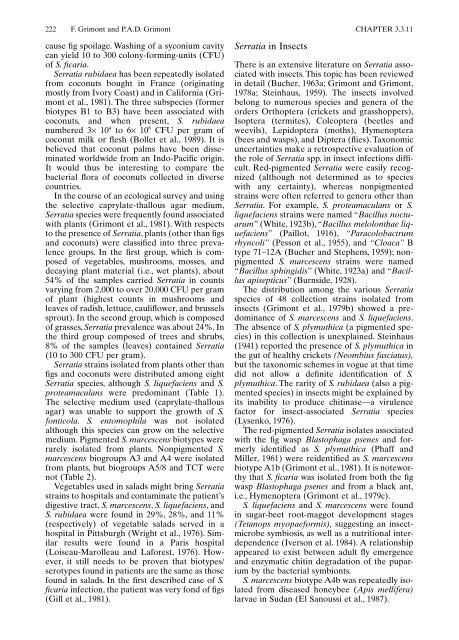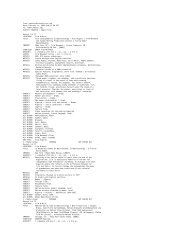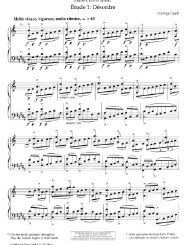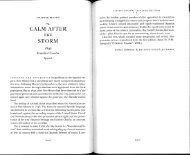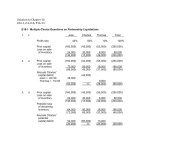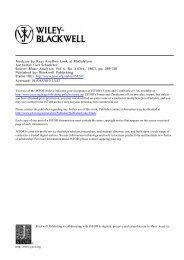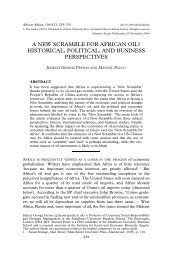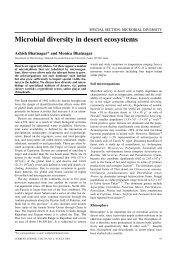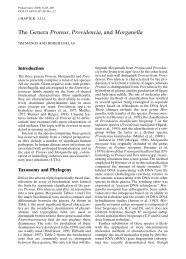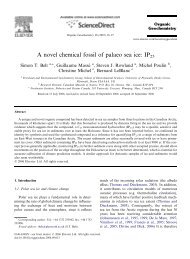The Genus Serratia
The Genus Serratia
The Genus Serratia
Create successful ePaper yourself
Turn your PDF publications into a flip-book with our unique Google optimized e-Paper software.
222 F. Grimont and P.A.D. Grimont CHAPTER 3.3.11<br />
cause fig spoilage. Washing of a syconium cavity<br />
can yield 10 to 300 colony-forming-units (CFU)<br />
of S. ficaria.<br />
<strong>Serratia</strong> rubidaea has been repeatedly isolated<br />
from coconuts bought in France (originating<br />
mostly from Ivory Coast) and in California (Grimont<br />
et al., 1981). <strong>The</strong> three subspecies (former<br />
biotypes B1 to B3) have been associated with<br />
coconuts, and when present, S. rubidaea<br />
numbered 3× 10 4 to 6× 10 6 CFU per gram of<br />
coconut milk or flesh (Bollet et al., 1989). It is<br />
believed that coconut palms have been disseminated<br />
worldwide from an Indo-Pacific origin.<br />
It would thus be interesting to compare the<br />
bacterial flora of coconuts collected in diverse<br />
countries.<br />
In the course of an ecological survey and using<br />
the selective caprylate-thallous agar medium,<br />
<strong>Serratia</strong> species were frequently found associated<br />
with plants (Grimont et al., 1981). With respects<br />
to the presence of <strong>Serratia</strong>, plants (other than figs<br />
and coconuts) were classified into three prevalence<br />
groups. In the first group, which is composed<br />
of vegetables, mushrooms, mosses, and<br />
decaying plant material (i.e., wet plants), about<br />
54% of the samples carried <strong>Serratia</strong> in counts<br />
varying from 2,000 to over 20,000 CFU per gram<br />
of plant (highest counts in mushrooms and<br />
leaves of radish, lettuce, cauliflower, and brussels<br />
sprout). In the second group, which is composed<br />
of grasses, <strong>Serratia</strong> prevalence was about 24%. In<br />
the third group composed of trees and shrubs,<br />
8% of the samples (leaves) contained <strong>Serratia</strong><br />
(10 to 300 CFU per gram).<br />
<strong>Serratia</strong> strains isolated from plants other than<br />
figs and coconuts were distributed among eight<br />
<strong>Serratia</strong> species, although S. liquefaciens and S.<br />
proteamaculans were predominant (Table 1).<br />
<strong>The</strong> selective medium used (caprylate-thallous<br />
agar) was unable to support the growth of S.<br />
fonticola. S. entomophila was not isolated<br />
although this species can grow on the selective<br />
medium. Pigmented S. marcescens biotypes were<br />
rarely isolated from plants. Nonpigmented S.<br />
marcescens biogroups A3 and A4 were isolated<br />
from plants, but biogroups A5/8 and TCT were<br />
not (Table 2).<br />
Vegetables used in salads might bring <strong>Serratia</strong><br />
strains to hospitals and contaminate the patient’s<br />
digestive tract. S. marcescens, S. liquefaciens, and<br />
S. rubidaea were found in 29%, 28%, and 11%<br />
(respectively) of vegetable salads served in a<br />
hospital in Pittsburgh (Wright et al., 1976). Similar<br />
results were found in a Paris hospital<br />
(Loiseau-Marolleau and Laforest, 1976). However,<br />
it still needs to be proven that biotypes/<br />
serotypes found in patients are the same as those<br />
found in salads. In the first described case of S.<br />
ficaria infection, the patient was very fond of figs<br />
(Gill et al., 1981).<br />
<strong>Serratia</strong> in Insects<br />
<strong>The</strong>re is an extensive literature on <strong>Serratia</strong> associated<br />
with insects. This topic has been reviewed<br />
in detail (Bucher, 1963a; Grimont and Grimont,<br />
1978a; Steinhaus, 1959). <strong>The</strong> insects involved<br />
belong to numerous species and genera of the<br />
orders Orthoptera (crickets and grasshoppers),<br />
Isoptera (termites), Coleoptera (beetles and<br />
weevils), Lepidoptera (moths), Hymenoptera<br />
(bees and wasps), and Diptera (flies). Taxonomic<br />
uncertainties make a retrospective evaluation of<br />
the role of <strong>Serratia</strong> spp. in insect infections difficult.<br />
Red-pigmented <strong>Serratia</strong> were easily recognized<br />
(although not determined as to species<br />
with any certainty), whereas nonpigmented<br />
strains were often referred to genera other than<br />
<strong>Serratia</strong>. For example, S. proteamaculans or S.<br />
liquefaciens strains were named “Bacillus noctuarum”<br />
(White, 1923b), “Bacillus melolonthae liquefaciens”<br />
(Paillot, 1916), “Paracolobactrum<br />
rhyncoli” (Pesson et al., 1955), and “Cloaca” B<br />
type 71–12A (Bucher and Stephens, 1959); nonpigmented<br />
S. marcescens strains were named<br />
“Bacillus sphingidis” (White, 1923a) and “Bacillus<br />
apisepticus” (Burnside, 1928).<br />
<strong>The</strong> distribution among the various <strong>Serratia</strong><br />
species of 48 collection strains isolated from<br />
insects (Grimont et al., 1979b) showed a predominance<br />
of S. marcescens and S. liquefaciens.<br />
<strong>The</strong> absence of S. plymuthica (a pigmented species)<br />
in this collection is unexplained. Steinhaus<br />
(1941) reported the presence of S. plymuthica in<br />
the gut of healthy crickets (Neombius fasciatus),<br />
but the taxonomic schemes in vogue at that time<br />
did not allow a definite identification of S.<br />
plymuthica. <strong>The</strong> rarity of S. rubidaea (also a pigmented<br />
species) in insects might be explained by<br />
its inability to produce chitinase—a virulence<br />
factor for insect-associated <strong>Serratia</strong> species<br />
(Lysenko, 1976).<br />
<strong>The</strong> red-pigmented <strong>Serratia</strong> isolates associated<br />
with the fig wasp Blastophaga psenes and formerly<br />
identified as S. plymuthica (Phaff and<br />
Miller, 1961) were reidentified as S. marcescens<br />
biotype A1b (Grimont et al., 1981). It is noteworthy<br />
that S. ficaria was isolated from both the fig<br />
wasp Blastophaga psenes and from a black ant,<br />
i.e., Hymenoptera (Grimont et al., 1979c).<br />
S. liquefaciens and S. marcescens were found<br />
in sugar-beet root-maggot development stages<br />
(Tetanops myopaeformis), suggesting an insectmicrobe<br />
symbiosis, as well as a nutritional interdependence<br />
(Iverson et al. 1984). A relationship<br />
appeared to exist between adult fly emergence<br />
and enzymatic chitin degradation of the puparium<br />
by the bacterial symbionts.<br />
S. marcescens biotype A4b was repeatedly isolated<br />
from diseased honeybee (Apis mellifera)<br />
larvae in Sudan (El Sanoussi et al., 1987).


